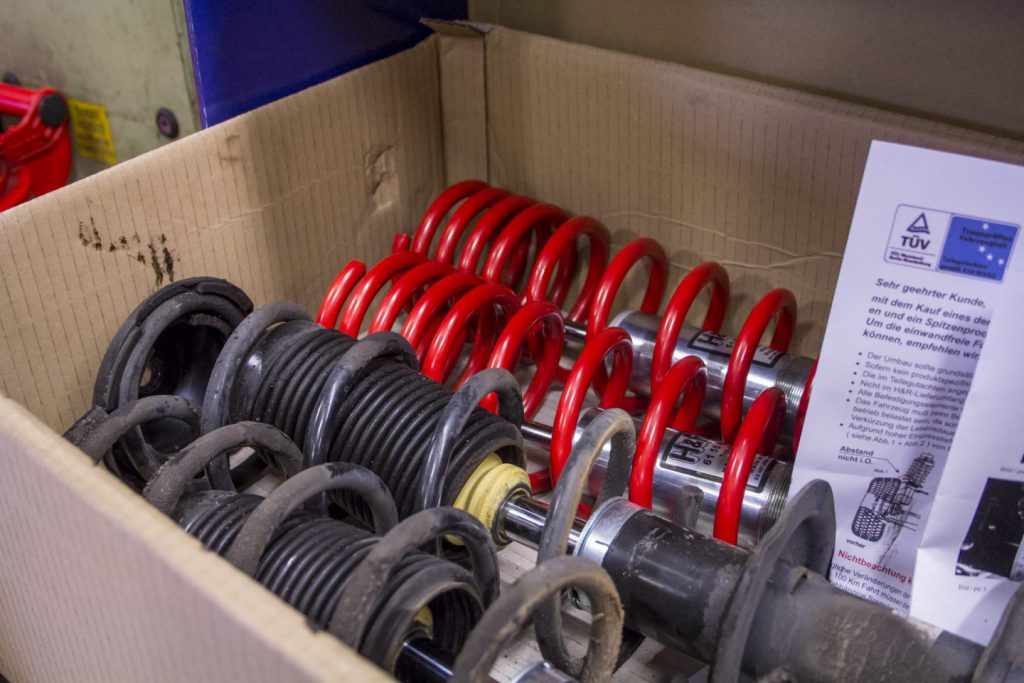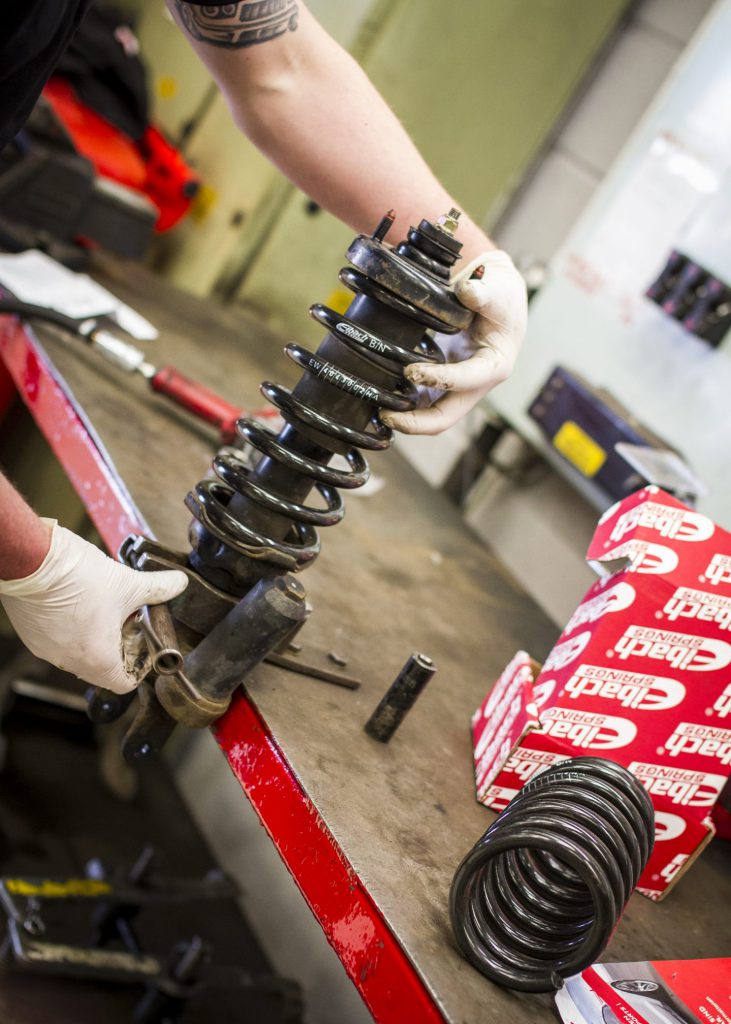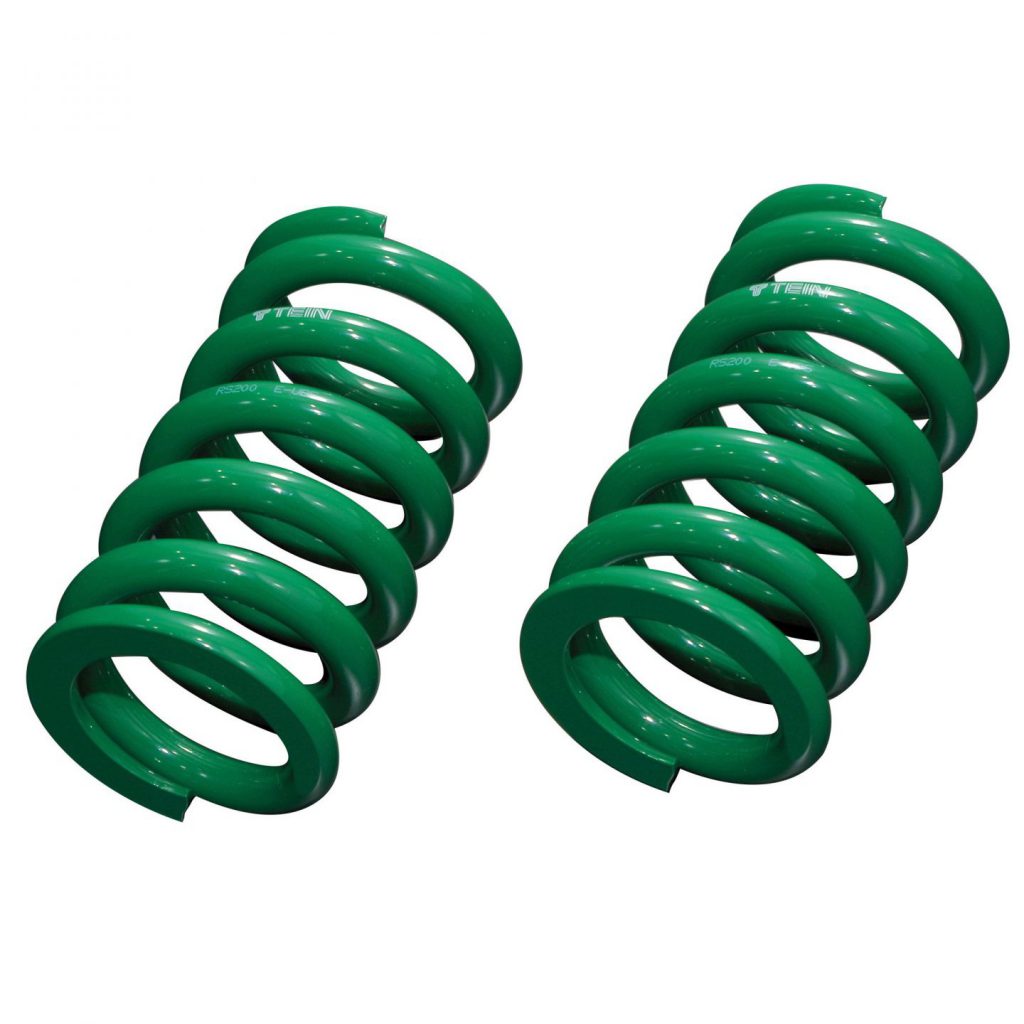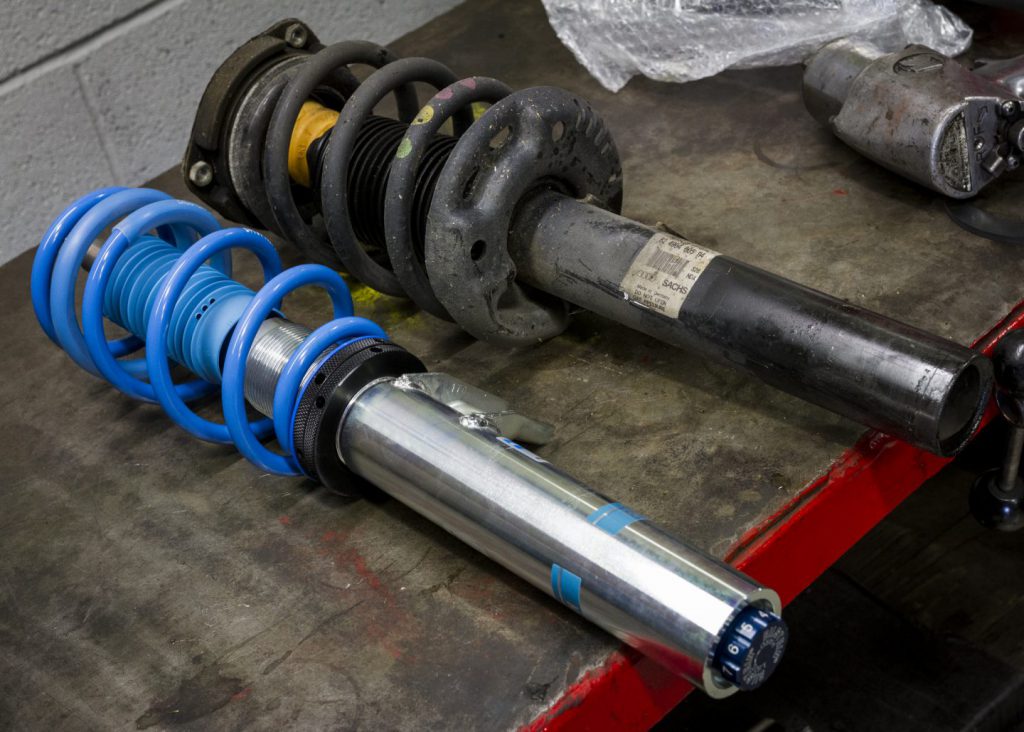
Lowering Springs are one of the cheapest and simplest ways to lower your car. We often talk about them as being the first step when you’re looking at the handling of your vehicle. This is because you can fit most lowering springs as a standalone upgrade, touching nothing else on the car.
They can also be just one part of an upgrade package too. For a reasonable outlay you can unlock a whole lot of handling improvements.
Why do I want to lower my car anyway?

As we talked about in our beginners guide to car handling, when you lower your car you’re lowering it’s centre of gravity. Lowering your cars centre of gravity makes it roll less when you corner. This means there’s less weight transfer onto the outside tyres and off the inside tyres. That means you enjoy more grip from all four tyres, which means a better connection with the road surface.
If you’re changing directions quickly (as in an S-bend for example), the car needs less time to settle back between direction changes.
It also improves the looks. Arch gaps are rarely a good look. If you drop your car a bit, you reduce the arch gaps. This makes your wheels look bigger and gives your car a sporty, aggressive stance.
How do Lowering Springs ride?

A common question when considering lowering a car or van is how it’s going to ride afterwards. It’s a very difficult question to answer exactly, because unless you have ridden in that specific model of vehicle with the specific lowering product in question fitted there’s always a bit of guesswork involved.
Unlike some of the cheaper “ebay special” springs you might see on sale, all the lowering springs we sell are very well engineered for the specific vehicle they are getting fitted to. This will reflect in the ride quality, with some approaching standard suspension like levels of comfort.
We’d expect you to notice that you have lowering springs fitted (otherwise, what is the point of fitting them?) but we wouldn’t expect the car to become crashy or uncomfortable.
Eibach’s Pro-Kit Lowering Springs for example are very notable for riding almost like the original springs.
Sportier lowering springs like Eibach Sportline are probably going to tip that balance a bit more towards the side of being firm. Fitting stiffer springs can have a more noticeable impact on the secondary ride of the car too. This is how the car rides over small bumps and rough road surface.
This does depend to a certain extent on what condition the rest of the suspension is. Your vehicle comes with shock absorbers and rubber bushes designed to help buffer you from the road surface you are driving on. If those other components are worn, then you are going to notice stiffer springs more than you would otherwise.
How low can I go with springs?

There are limits to what you can achieve if you’re using a spring that must pair up to a standard shock absorber. Generally mild lowering springs offer around 30mm lowering. Sportier springs tend to offer between 45mm and 60mm. This does depend a bit on the car. Newer cars tend to have less travel to begin with in the suspension, so the lowering on offer will be less.
What if my car already has sports suspension?
If you drive a hot-model (a GTi, S3, RS, AMG) or the sports suspension box (S-Line, R-Line, AMG-Line, M-Sport, M-Technic etc.) was ticked when the car was first ordered it may well already be lowered.
A lot of lowering springs fit both standard and sports suspension and the lowering amount they provide will be for a car with standard suspension. If your car is already lowered, you will need to subtract the amount the car is already lowered from what the new springs will do. In some cases, optional sports suspension can lower the car so much that some aftermarket springs don’t lower it. S-Line on some recent Audis lowers the car by 30mm which means many aftermarket springs don’t lower by much or at all.
Do I need to replace anything else?
Many of the lowering springs we sell are TUV approved. TUV approval means that part can be fitted to an otherwise standard car. This means in most cases you don’t need to replace anything.
It’s worth bearing in mind that lowering springs are going to give your shock absorbers a bit more of a workout, so if they were on their way out anyway, they will hasten their demise. It’s worth considering replacing anything that seems worn on the suspension while you’re taking it to bits to fit springs.
We also tend to recommend fitting sports dampers when fitting lower and stiffer lowering springs. When you’re looking at the 45-60mm lowering spring, they certainly work better when paired with a sports damper. As the spring is going to be stiffer than stock, a stiffer damper will do a better job of controlling it and can help avoid the car feeling “busy” over rough road surface.
What upgrades go well with lowering springs?
Lowering Springs are like cheese. Great on their own, but even better when combined with other things.
Sports Dampers
As we mentioned above, an uprated sports damper pairs very nicely with lowering springs. The lowering spring will be somewhat stiffer than the original spring, which means that while they will work fine with your original dampers, they will work better with a firmer sports damper controlling them.
Some manufacturers offer kits of spring and damper, or you can choose dampers separately.
Anti-Roll Bars and Wheel Spacers
You could also look at complementary upgrades like anti-roll bars and wheel spacers. These upgrades both help control body roll (albeit they achieve this through slightly different means). Fitting either or both alongside springs which are already reducing body-roll is going to magnify the benefits.
An anti-roll bar (or sway-bar) is a popular suspension upgrade in it’s own right. On front wheel drive cars, fitting an uprated rear bar will help to tame understeer.
Wheel spacers help both looks and handling, by spacing the wheels out. Making the track of the car wider also lowers its centre of gravity.
Do Lowering Springs work with adaptive damping?
One of the nice things about lowering springs as an upgrade, is they leave your dampers completely untouched. If your dampers contain fancy electronic valveing and the like, you get to retain all the benefits of this system, whilst gaining the benefits of a lowering spring.
Do I need a TUV certificate?
TUV approval is a German safety standard. Many of the lowering springs we offer are TUV approved. This basically means they have passed testing and been proven to fit and work safely with the original equipment on the car. This is certainly good for your peace of mind and speaks well for the quality of the springs.
Either supplied with the suspension, or available to download, will be a copy of a TUV testing certificate. This will mention the specific product in combination with the car it is supposed to fit.
Whether you need the certificate or not probably depends on where the car is going to be driven. In some countries in Europe, it’s very important to have paperwork for your modifications. This is particularly true of Germany. On the other hand, you may drive in a country where the paperwork is not needed.
It’s also worth bearing in mind that we sell brands of suspension aimed at countries where TUV is not required. Tein are Japanese and will have been put through equally stringent testing in Japan, but as they don’t primarily sell in Europe, they have not been TUV tested.
Do I want linear or progressive springs?

One question we do get asked often is if the springs we offer are linear or progressive rate. This is a difference in how the springs are wound. A linear-rate spring has it’s coils an equal distance apart and offers the same amount of resistance as it gets compressed.
A progressive-rate spring is wound differently, with visibly larger gaps between some coils. As the spring compresses, it will offer more resistance. The idea is generally that the initial travel of the spring is quite soft, but as the car leans over more on it, it becomes firmer.
Progressive rate springs are widely used by manufacturers when designing suspension for road use. A bit of softer initial travel helps keep the car in contact with the road over bumps and the like and helps the secondary ride of the car. The firmer travel at the end of the spring helps avoid bottoming out the suspension and gives firmer handling during harsher cornering when you need it.
This lack of a constant spring rate can make a car less predictable compared to linear rate springs. This is normally the sort of thing you’d consider when setting up a track car, where it is going to spend more of its time cornering hard. On a daily driver you’re probably not going to be cornering fast enough for the slight variances in spring rate to bother you.
You do not normally get a choice when buying a suspension kit, particularly lowering springs. The engineers designing the product will have chosen the best spring for each corner of the car. We’d anticipate that most lowering spring kits we sell for road use will use progressive rate springs somewhere.
Lowering springs vs Coilovers?

We sometimes get asked how these upgrades compare. This is a tricky question.
A good coilover is always going to offer better handling than a good lowering spring. Anything that you can fit to the car as a separate upgrade (so lowering springs and sports dampers) must work with the rest of the OE suspension which limits it somewhat.
A coilover on the other hand is a matched pairing of uprated damper and spring. Because it’s been developed as a total package and neither component must match the factory parts, more can be achieved with a good coilover.
We did say a good coilover though. We’ve seen some very cheap coilovers on the market, which might look tempting price-wise when compared to a premium lowering spring and damper combo. We think you often get what you pay for though. Many of these cheap coilovers will just not have been engineered to the same degree as premium brands. It’s not uncommon for these to not ride well at all. We’d have concerns about driving a car very hard on them too.
Lowering a car whilst still leaving it riding well is a bit of an art form and if ride quality is a priority we’d probably steering clear of budget coilovers in favour of higher quality lowering springs, and possibly shock absorbers.

I have a 2005 Cadillac STS sedan with a V/8 engine . I would like to lower the front only about 2”. Are there springs available to do that?. Thanks